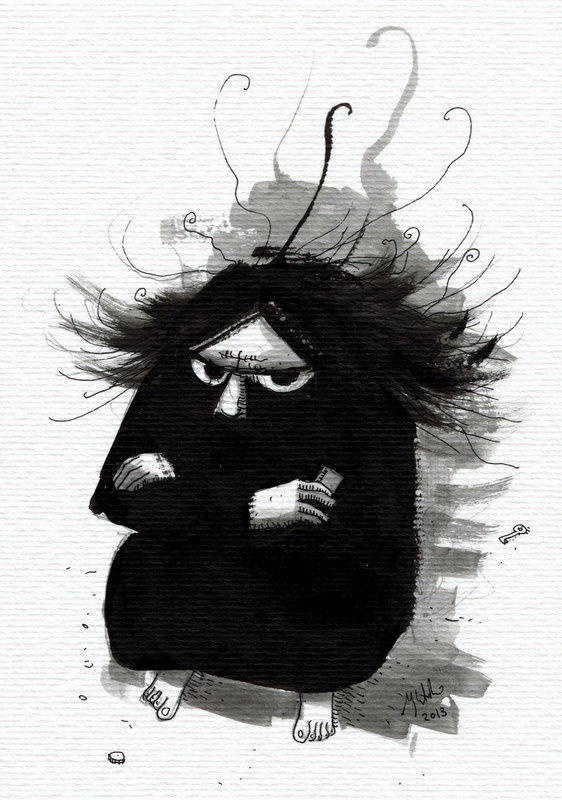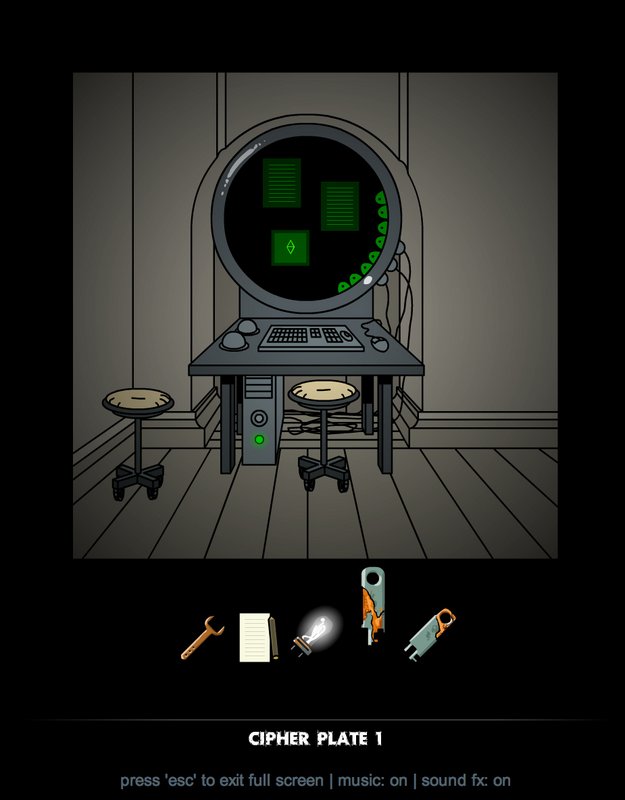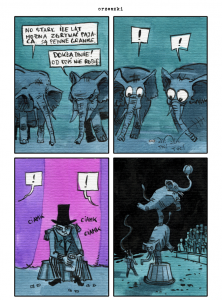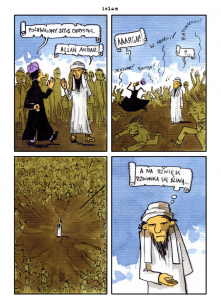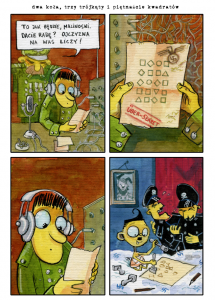Daymare evolution…
June 3, 2013
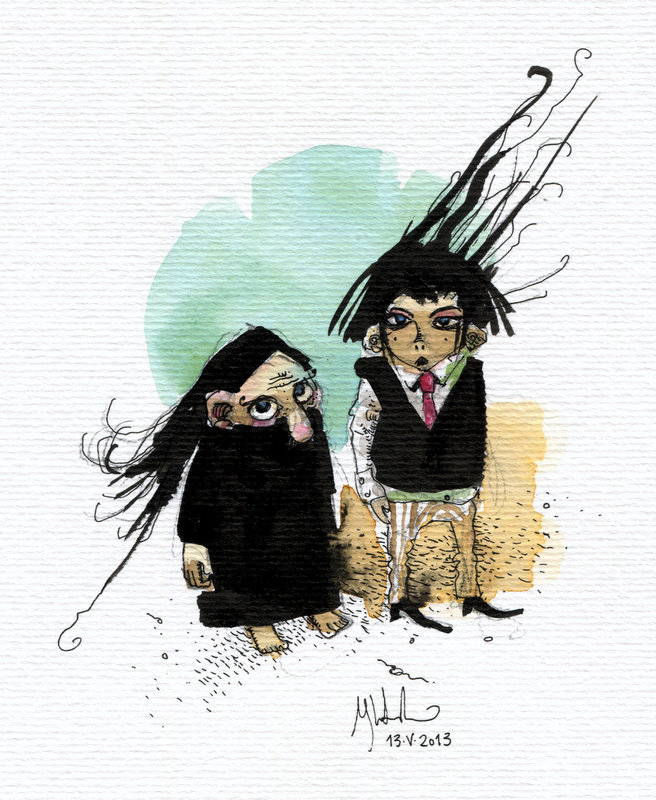
attention:
don’t worry, daymaretown 4 still looks exactly like previous ones.
This is just a sketch of what might come in the future as a brand new series,
evolved from daymare and submachine for example (people + machines).
We cool? :D
Submachine 6: the Edge HD
May 16, 2013
Submachine 6: the Edge is now available in the HD format. Click here to purchase the game.
Tetrastych
May 14, 2013
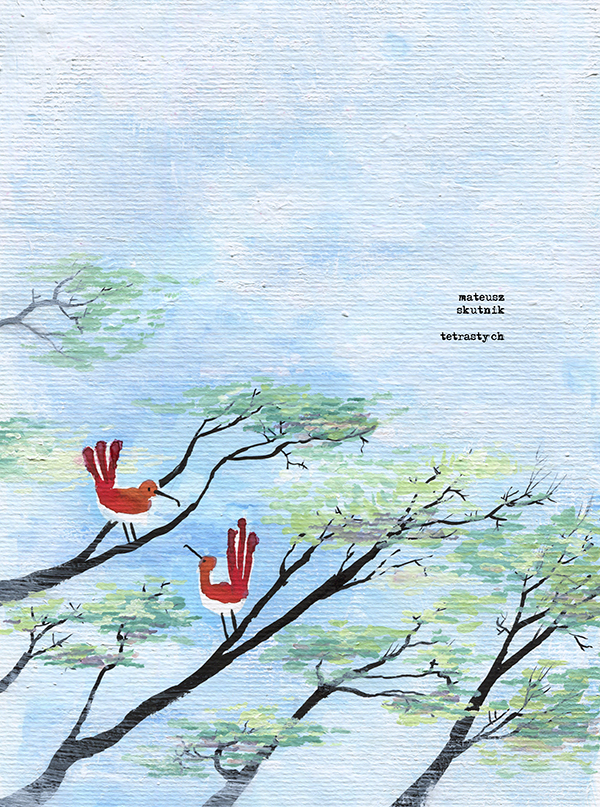
Tetrastych, czyli czterowiersz jest zbiorem 52 jednoplanszówek. Każda z nich składa się z czterech kadrów. To efekt cotygodniowego konkursu na pasek komiksowy odbywajacego się na forum Gildii Komiksu, w którym uczestniczyłem przez równy rok (październik 2011 – październik 2012). Te konkursy trwają do dziś, każdy może się tam zmierzyć z innymi rysownikami. Co tydzień pojawia się nowy temat do zrealizowania w formie paska komiksowego. Stąd 52 plansze, stąd format, stąd rygor i stąd efekt. Każda strona opatrzona jest odpowiednim konkursowym tytułem, bez niego większość stron/pasków byłaby niezrozumiała i nieśmieszna. Album ten jest bardziej zapisem procesu twórczego niż zbiorem najlepszych prac – znalazły się w nim wszystkie paski, lepsze, gorsze, trafiające w sedno tematu konkursu, bądź bardziej abstrakcyjne.
Recenzje:
I Like Weird Stuff; take on the Submachines
May 13, 2013
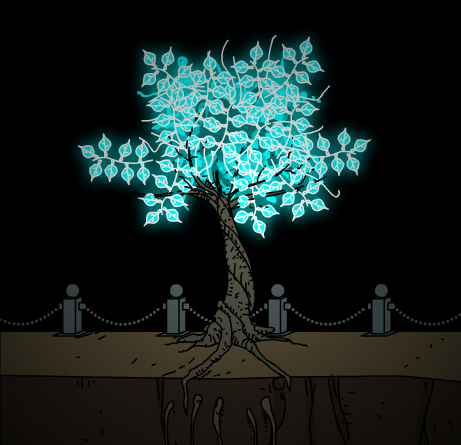
How to Spend Friday Night At Home: The Submachine Series
They take seconds to load, cost no money, and can last for hours of gameplay. Point and click games are mega popular in the world of internet gaming. What started as an internet trend with the likes of Myst, MOTAS (Mystery of Time and Space) and Crimson Room exploded into a bustling genre of free internet gaming. While most waver between pleasant distraction and wall-punching frustration, only one series is smooth to the touch, fun, and deeply cerebrally discomforting. Meet Submachine.
Sidenote Preface: I know most of you are on a high after the fruits of weeks of hashmobbing got us a renewal of Community. The behavior of obsessives never ceases to amaze me, considering I can only retain a passing interest in the things I absolutely adore; I can’t imagine that level of organization and determination being continuously carried out for months at a time. It is a skill I do not have anymore. However, those lovely Communies have now earned a pleasant evening off, and this is a great way to immerse yourself into something else and let the Community fever subside for a while.
The Submachine series is by no means a series of horror games. Things will not go bump in the night. Slenderman won’t come and get you. The fright comes in the story, and in the eerie surroundings. You see, you, the player, are alone. You are alone in a world so far removed from the standards of your own that one step could land you in a different season, in a different gravity, in a different time. The rules don’t apply here, because this world was made without conventional rules, by either a genius or a madman.
That genius madman talks to you. He leaves you little notes giving you clues on how to continue going deeper into the machine. He wants you to travel deeper and explore it like he did, and change it like he did. You’re the only one who’s made it this far and survived. There were others, but you never meet them, or find their bodies. All you see are notes, loosely taped to brick walls or crumpled beneath machines powered by anything from steam to psychic crystal.
That genius madman is Mur, short for Murtaugh, the man who binds the series together by putting you on his trail. It is no surprise that fans lovingly refer to artist and creator Mateusz Skutnik as Mur himself. There is some meta to this building wave of puzzle insanity.
Play it in the dark, with headphones, listening to the deep beats and spine-tingling ambiance of ThumpMonks. Play alone, at night, with a closed and locked door, while the world is asleep. Play when you feel nothing but alone. There are no ghosts and goblins that can scare you the way being the only person alive in an empty dimension can. Play while cannabinized for added effect, it is mind-altering.
The Submachine series has spawned eight games, three side-quest games, and an extended observation and mini-puzzle known as the “Submachine Network Exploration Experience.” The fan community continues to theorize about the purpose of the Submachine and its mysterious and convoluted existence as it awaits the last two games of the series. Often compared to LOST, Submachine has been keeping online gamers guessing for eight years. But will the payoff be worth the years of mystery, suspense, and deep guttural fear? There’s no way of knowing, but just like LOST, the journey is most of the fun, and even with a lack of payoff it was all worth it.
And if you like getting freaked out by that same sense of loneliness, but want to amp it up with some fucking weird circus sideshow creepy town dudes, check out Daymare Town. The only thing creepier than a nightmare is a daymare.
Tetrastych; recenzja Karola Konwerskiego
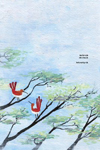 Każdy z nas zna dowcip, który jest niezmiernie zabawny że hahaha i hohoho, a nawet hyhyy tylko żeby do tego hhihihi doszło, trzeba opowiedzieć długą momentami nudnawą historię stanowiącą wstęp rozwinięcie i wprowadzenie do zakończenia i pointy, którą ów dowcip jest.
Każdy z nas zna dowcip, który jest niezmiernie zabawny że hahaha i hohoho, a nawet hyhyy tylko żeby do tego hhihihi doszło, trzeba opowiedzieć długą momentami nudnawą historię stanowiącą wstęp rozwinięcie i wprowadzenie do zakończenia i pointy, którą ów dowcip jest.
Coś jak to zdanie powyżej.
W połowie tych 222 znaków (bez spacji) połowa z potencjalnych czytelników ziewnęła, druga połowa przestała czytać, trzecia połowa szuka wzrokiem ilustracji a czwarta…
Dobra dość.
Sam zasypiam pisząc to i być może z tego samego powodu wydawca ( a być może i sam autor nie pomyślał) nowego albumu Mateusza Skutnika zrezygnował z jakiegokolwiek wprowadzenia do tej publikacji.
Problem w tym, że bez wstępu i tego wprowadzenia zbiór tych pasków komiksowych, będzie kolejnym zbiorem pasków komiksowych.
Mało tego, to dziwny zestaw „czterokadrowców”, w którego skład weszło zbyt wiele komiksów mało udanych, nietrafionych lub zwyczajnie bo ludzku ani nie zabawnych, ani nie melancholijnie lirycznych (jak to u Skutnika), tylko po prostu nijakich. Oczywiście album powinien się bronić sam, ale w tym konkretnym przypadku bez znajomości przyczyn jego powstania czytelnik sporo traci.
Zatem słowem wstępu którego trudno szukać w albumie, na okładce lub gdziekolwiek indziej. “Tetrastych” to zbiór czterokadrowych komiksów, które powstały w ciągu 52 tygodni w ramach konkursu na pasek forum gidii komiksu.
Co tydzień nowa edycja konkursu i co tydzień nowy temat, bo co najistotniejsze w tym całym przedsięwzięciu to właśnie to: co tydzień nowy temat, co tydzień nowy pasek i tak 52 razy.
Bardziej niż same komiksy istotniejszy jest dla mnie ten kontekst. Bo jakie komiksy powstają lub powstawać będą rękoma polskich autorów mniej więcej wiem, dlatego bardziej interesuje mnie to jak oni pracują, jak tworzą swoje obrazkowe historie. „Tetrastych” jest takim szkicownikiem jak szkicowniki wydawnictwa ATY, zapisem pracy autora. Nie tylko tego jak rysuje, opowiada ale tego jak myśli i na ile jest w tym swoim myśleniu twórczy ,w końcu to 52 tygodnie i co tydzień nowy wymyślony przez kogoś temat
A same paski?
Są różne. Opowiadanie pasków to trochę tak jak tłumaczenie komuś nie tyle dowcipu co tego jak ktoś jakiś dowcip opowiada więc darujcie nie opowiem, a pokaże.
W ciągu tych 52 tygodni Skutnik potrafi być dowcipny melancholijny czy ironiczny jak tu:
A jednocześnie potrafi być na siłę dowcipny, lub co gorsza nijaki, a częściej zaplątany we własną historie, która próbuje opowiedzieć. Plącze się i kombinuje by w efekcie wystrzelić laserem nietrafionej pointy w próżnie kosmosu gdzie jak wiadomo zapada grobowa cisza…
Jak tutaj:
Długo się zastanawiałem o co tutaj chodzi i przyznam, że bez pomocy nie domyśliłbym się że to nawiązanie do psów Pawłowa… Zamiast trafnej i dowcipnej pointy muszę znaleźć tłumaczenie do dowcipu ksiądz, arab, rusek i jego pies idą przez pustynię…
To, że Skutnik nie potrafi rysować wiemy od 2004 roku, ręce nie te twarze nie te świat w jego komiksach jest jakiś taki krzywy i szkicowy. Z roku na rok z albumu na album jest w tym nie potrafieniu coraz lepszy.
Bo to jak coś rysuje jest podporządkowane temu Co rysuje. „Tetrastych” to 52 przykłady na to jak fenomenalnie opanował on narracje obrazem, nie tylko na prostym poziomie „ to jest historia, opowiedz ją 4 kadrami” ale dalej i szerzej.
Skutnika historyjki nie zmykają się w tych 4 kadrach one skądś wychodzą i gdzieś biegną dalej. Czytając je znika nam granica ramki, kadru, strony. Ptaki na drzewie gadają ze sobą dalej lub odlatują na zimę, babcie zagłosowały, a teraz piją razem gdzieś herbatę. To wszystko jest jakimś ciągiem fabuł z których autor wyrwał jedynie czterokadrowy fragment.
Na koniec drobna rada/podpowiedź gdy będziecie czytać ten album zerknijcie czasem do internetu i sprawdźcie jak inni autorzy radzili sobie z narzuconymi tematami jak ten mój ulubiony: „Dwa koła, trzy trójkąty i piętnaście kwadratów”.
Karol Konwerski
Tetrastych; recenzja na Ziniolu
 52 komiksy w 52 tygodnie – jak sobie założył, tak zrobił. Mateusz Skutnik dla potrzeb “Tetrastychu” wybrał formę czterokadru planszowego. I na każdym z tych czterokadrów przedstawił jakąś historyjkę, zazwyczaj będąc (lub starając się być) zabawnym bądź nostalgicznym.
52 komiksy w 52 tygodnie – jak sobie założył, tak zrobił. Mateusz Skutnik dla potrzeb “Tetrastychu” wybrał formę czterokadru planszowego. I na każdym z tych czterokadrów przedstawił jakąś historyjkę, zazwyczaj będąc (lub starając się być) zabawnym bądź nostalgicznym.
Na stronie 11 albumu znalazło się miejsce dla kawałka pod tytułem “Święty”. Oto typowy martyr robi coś “w imieniu Pana”. Efekt jego działania powoduje charakterystyczny “plask” w czoło skonfudowanego Boga, spoglądającego na sytuację z perspektywy niebios. Tego rodzaju “plask” często towarzyszy lekturze “Tertastychu”. Skutnik w części historyjek wywołuje jeśli nie zażenowanie, to co najwyżej wzruszenie ramion. Z miałkim dowcipem zbyt często ramię w ramię idzie równie mizerny rysunek – tu jakieś nieudane próby cartoonowe, tam jakieś prześwity z “Muminków”, jeszcze gdzie indziej chyba jeden z najgorszych wytrzeszczy oczu, jakie kiedykolwiek zobaczycie… są w “Tetrastychu” plansze, które pokazuję kiepską formę Skutnika. Ale są również takie, które ukazują jego bezapelacyjny geniusz.
Absolutnym mistrzostwem świata, z czterokadru wyciskającym dosłownie wszystko, skomponowanym w sposób nakazujący paść na kolana przed autorem, są takie kawałki, jak “Trzy kwadraty”, “Żule”, “Książka”, “Sen” i “Luneta”. Poza nimi – kilkanaście innych, a wśród nich rozbrajające “Honor” i “Ptaki”, graficznie nawiązujące do “starego Skutnika” “Dzieci”, piękna “Gra cieni”, fenomenalna “Głębia”, dosłowna “Farba” i równie zabawna “Jesień”. Skutnik nie utrzymał wysokiej formy, ale w zaprezentowanych pracach zrobił rozstrzał totalny – od kompletnego badziewia po dzieło absolutnie genialne w każdej swojej kresce.
Kupuję ten rozstrzał. “Rewolucje” to serial wciąż zwyżkujący, ukazujący się raz do roku, będący dla Skutnika platformą do tworzenia światów i budowania przestrzeni. Ukazujące się z doskoku albumy prezentujące pozarewolucyjny dorobek autora, to już bądź dzieła zebrane (“Komiksy znalezione na strychu”), bądź poddane pewnemu rygorowi, narzuconemu przez twórcę (“Tetrastych”). Poziom tych “albumów z doskoku” jest przeróżny, podobnie jak poziom zaprezentowanych tam historii. Jest i dobrze i źle, przy czym zapewne to dobro i zło dla każdego będzie inne.
“Tetrastych” opublikowało Wydawnictwo Komiksowe, ale zachowana została “skutnikowa” oprawa albumu, znana z wcześniejszych wydań – komiks wydrukowano w formacie A4, a na ostatniej stronie okładki zamieszczono okładki wszystkich dotychczas wydanych albumów Mateusza Skutnika. Jedyną różnicą jest lakier na okładce. Wydawnictwu Komiksowemu należą się wielkie brawa za podtrzymanie tej stylistyki.
“Tetrastych” jest nierówny, ale jestem przekonany, że każdy czytelnik odnajdzie w tym albumie choć jedną planszę, która zwali go z nóg. Ja znalazłem 21.
Dominik Szcześniak
« Previous Page — Next Page »









